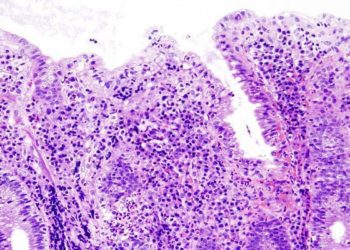2 Minute Medicine Rewind June 21, 2021
1. A nationwide Swedish study demonstrated that patients with congenital heart disease are at an increased risk of developing ischemic stroke compared to controls.
Evidence Rating Level: 3 (Average)
Congenital heart disease (CHD) is the most common major congenital anomaly, and it is associated with an increased risk of complications such as arrythmias and heart failure. Although studies have demonstrated increased risk of ischemic stroke (IS) in patients with CHD, there are limited studies about long-term outcomes in such patients. This case-control study aimed to evaluate the cumulative incidence and risk of developing IS as well as determine risk of developing recurrent and all-cause mortality after IS in patients with CHD compared to controls. Data collection included 88,700 patients with CHD (50.6% men) and 890,450 controls (51% men) without CHD. It demonstrated that patients with CHD to develop IS were control median age, 66.0 [IQR, 57.1–73.4] years; p<0.001). Patients with CHD had a 5-fold increased risk of developing IS compared to their controls (HR, 5.01; 95% CI, 4.81–5.22). The risk of developing recurrent IS was 34% lower in patients with CHD compared to their controls (HR, 0.66; 95% CI, 0.56–0.78). However, patients with CHD were younger than the controls at the recurrent IS (median age, 61.6[IQR, 50.3–70.6] years versus 71.0[IQR, 65.0–77.0] years; p<0.001). Similarly, the risk of all-cause mortality in patients with CHD was around half that of controls (HR, 0.53; 95% CI, 0.49–0.58) However, patients with CHD who died after an IS were younger compared to their controls (median age, 67.9[IQR, 53.7–76.6] years for versus 73.0[IQR, 66.1–78.6] years for controls; p<0.001). Overall, this study demonstrated that patients with CHD had an increased risk of developing IS, yet, their risk of recurrent IS and all-cause mortality was lower compared to controls. Although this study had a large sample size and limited attrition, future better-quality evidence such as prospective cohort studies are needed to further establish these conclusions.
1. A prospective observational study demonstrated moderate agreement between clinicians and researchers in assigning patients a HEART score.
Evidence Rating Level: 2 (Good)
The HEART score is a risk stratification aid used frequently in emergency departments (ED) to estimate the probability of major adverse cardiac events within 30 days for patients with symptoms concerning for acute coronary syndrome. Although validation studies on this tool have been conducted, there is limited research to demonstrate the utility of the HEART score when used by a clinician outside research settings. This prospective study aimed to evaluate the agreement between HEART scores calculated during practice (clinician scores) and scores generated using standardized research methods (research scores) as well as determine the accuracy of these scores in predicting 30-day adverse cardiac events. The study included 336 participants (53% men; median age, 59 years), many with multiple comorbidities such as hypertension, dyslipidemia, and diabetes mellitus. The primary outcome measured was agreement between clinician and research dichotomous HEART scores, defined as low-risk (0 to 3) versus moderate-to-high risk (4 to 15). Dichotomous HEART score agreement between clinicians and researchers was 78% (n=263). 49 patients scored by clinicians to be moderate-to-high risk had low-risk researcher scores and 24 patients scored as low risk by clinicians had moderate-to-high risk researcher scores. In terms of the components of the score, agreement was highest for age (96.7%) and troponins (98%). It was lowest for history (72%), with clinicians assigning a higher mean history score. There were 73 discordant scores, of which 59% (n=43) varied by 1 point, 37% (n=27) varied by 2 points and 4% (n=3) varied by 3 points. History, risk factors, and ECG interpretations had the highest rates of disagreements in discordant scores (44.7%, 32.5%, and 19.3%, respectively). Compared to research-generated HEART scores, ED clinicians’ HEART scores demonstrated higher sensitivity (100%; 95% CI, 88.4%-100% versus 86.7%; 95% CI 69.3%-96.2%) and lower specificity (27.8%; 95% CI 22.8%-33.2% versus 34.6%; 95% CI 29.3%-40.3%) in predicting 30-day major adverse cardiac events. Although this was a smaller single-centered study, it helped shed light on disagreements between clinician HEART scores and those calculated by researchers. In culmination, study findings provide insight into the limitations of utilizing HEART scores as the sole determinant of patient disposition.
1. In a group of extremely preterm infants, using a new respiratory support system with low imposed work of breathing and short binasal prongs decreased delivery room intubation.
Evidence Rating Level: 1 (Excellent)
A recent development in oxygen delivery is a system that delivers continuous positive airway pressure (CPAP) via nasal prongs rather than a T-piece system used conventionally. Studies have demonstrated that this system has a decreased imposed work of breathing (workload needed to breathe through the system). This randomized clinical trial aimed to evaluate whether utilizing this new system results in a decreased need for intubation in extremely preterm infants (born before 28 weeks gestational age). There were 246 infants included in the study; 124 were assigned to the new respiratory system and 122 were assigned to the conventional T-piece. The mean (SD) gestational age was 25.8 (1.3) weeks. The primary outcome measured by the study was intubation or death in the delivery room (time frame of 0 – 30 minutes). The incidence of the primary outcome was decreased amongst infants in the new respiratory support system group (33.1%, n=4) compared to the T-piece group (45.1%, n=55). The adjusted odds ratio was 0.53 with a 95% confidence interval of 0.30 to 0.94 (p=0.03). Thus, there was a decreased risk of death or intubation within the specified time frame amongst infants in the new respiratory support system group (−14.6%; 95% CI, −26.5 to −2.6). However, the study reported that there were two infants from the new respiratory support system group that were either intubated or died after the indicated time frame (one at 45 minutes and one at 66 minutes). Overall, the study concluded that the new respiratory support system decreased death and intubation when stabilizing extremely premature infants. Although this has the potential to change standard clinical practice in the future, larger scale studies are needed to confirm these results before establishing its use.
1. In a cohort of adults from the UK, replacing sedentary behaviour with moderate-to-vigorous activity was associated with decreased anxiety and depression symptoms.
Evidence Rating Level: 2 (Good)
Sedentary behaviour levels, such as sitting or lying down, have been shown to increase in recent years. Some studies have demonstrated that high sedentary behaviour is a risk factor for depression and anxiety in adults, however, results are inconsistent. This prospective cohort study aimed to determine the association between accelerometer-derived sedentary behaviour and depression and anxiety symptoms. 60, 235 participants were included in the study (56% female, mean age [SD], 55.9 [7.7] years). The primary outcomes measured were the continuous symptom scores on the PHQ-9 and GAD-7, which are validated tools used to measure depression and anxiety, respectively. Baseline time in sedentary behaviours was positively associated with depression (β = 0.49; 95% CI, 0.44–0.54; p < 0.001) and anxiety (β = 0.37; 95% CI, 0.31–0.44; p < 0.001) symptom scores. The study found that replacing 60 minutes of sedentary behaviour with 60 minutes of light activity, moderate-to-vigorous activity, and sleep in a 24-hour period was associated with lower depression symptoms scores by 1.3% (95% CI, 0.4–2.1%), 12.5% (95% CI, 11.4–13.5%), and 7.6% (95% CI, 6.9–8.4%), respectively. Replacing 60 minutes of sedentary behaviour with moderate-to-vigorous activity and sleep was associated with lower anxiety symptom scores by 6.6% (95% CI, 5.5–7.6%), and 4.5% (95% CI, 3.7–5.2%). However, replacing it with 60 minutes of light activity was associated with higher anxiety symptom scores by 4.5% (95% CI, 3.7%–5.3%). Thus, the study concluded that although moderate-to-vigorous activity is associated with decreased anxiety and depression symptoms, the effects of light activity did not demonstrate the same advantages. Given the mixed findings and the study’s limited generalizability, more research is needed to establish this conclusion.
1. In a cohort of older adults undergoing surgery for a hip fracture, the presence of pre-operative frailty was associated with increased post-operative complications.
Evidence Rating Level: 2 (Good)
Hip fractures in the elderly represent a high source of morbidity and mortal in the older adult population. Surgery is often the best treatment for such fractures however it can lead to various adverse events in this population. Although previous studies have explored the relationship between frailty and post-operative complications, most were conducted in western countries, limiting their generalizability worldwide. This retrospective cohort study aimed to determine the effectiveness of a preoperative modified frailty index (mFI) in predicting post-operative complications in older Chinese patients with hip fractures. The primary outcomes measured were post-operative complications (divided into severity grades I, II, and III) and in-hospital pneumonia. Of 965 patients included in the study (66% female; mean age=76.77 years), 126 were in the frailty group. The median (range) mFI score was 0.12 (0-0.39). The study found that greater number of patients without frailty had no complications versus those with frailty (77.7% versus 61.9%). The odds of having a higher grade (I, II, or III) complication was increased in those with frailty compared to adults without frailty (OR, 2.07; 95% CI, 1.40-3.05; p < 0.001). Additionally, for an increase in mFI score by 0.01, the risk of severity grades of all post-operative complications increased by 1.07 (95% CI, 1.04-1.09). Patients with frailty were more likely to develop in-hospital pneumonia than their non-frail counterparts (20.6% versus 11.1%) and they demonstrated a statistically increased risk of developing in-hospital pneumonia (OR, 2.08; 95% CI, 1.28-3.39; p=0.003). Finally, an increase in mFI score by 0.01 increased the risk of developing in-hospital pneumonia by 1.07 (95% CI, 1.05-1.10). Overall, the study concluded that increased frailty was associated with increased risk of post-operative complications and in-hospital pneumonia. It was an important study demonstrating that frailty is useful prognostic information in this population.
Image: PD
©2021 2 Minute Medicine, Inc. All rights reserved. No works may be reproduced without expressed written consent from 2 Minute Medicine, Inc. Inquire about licensing here. No article should be construed as medical advice and is not intended as such by the authors or by 2 Minute Medicine, Inc.








